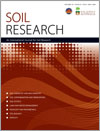SR16011Effects of soil composition and preparation on the prediction of particle size distribution using mid-infrared spectroscopy and partial least-squares regression
Soil composition, heterogeneity and carbonate content can affect the prediction accuracy of particle size distribution (PSD) using mid-infrared diffuse reflectance and partial least-squares regression (PLSR). Single large global calibrations could be used for PSD predictions of specific soil sets and showed improvement by fine grinding. The PLSR loading weights, associated with grinding, were linked to a reduction of inter- and intra-particulate heterogeneity and access of the infrared into the soil matrix by removal or dilution of surface coatings.




